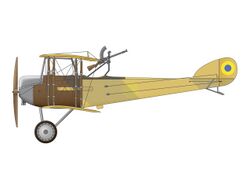Engineering:Anatra D
| Anatra D | |
|---|---|
| Role | Reconnaissance aircraft |
| Manufacturer | Anatra |
| Designer | Elysée Alfred Descamps |
| First flight | 19 December 1915[1] |
| Number built | 170[1] |
| Variants | Anatra DS |

The Anatra D or Anade was a two-seat reconnaissance aircraft built in Russia and flown during World War I. It was a two-bay biplane of conventional configuration that seated the pilot and observer in tandem, open cockpits. Test flights revealed a number of design flaws, including weak wing structure (that killed company test pilot Jean Robinet on 21 July 1917)[2] and poor stability. Nevertheless, the aircraft was ordered into production by the Army, and deliveries commenced in May 1916 after revisions had been made to correct the aircraft's centre of gravity in the hope of addressing the worst handling problems. The type continued in limited service after the war, eventually being used as a trainer until about 1919.
Operators
 Russia
Russia
- Imperial Russian Air Force : Initial deliveries began on 16 May 1916 with 170 acquired[1]
 Ukraine
Ukraine
- Ukrainian People's Republic Air Fleet
 Soviet Union
Soviet Union
Specifications
General characteristics
- Crew: two, pilot and observer
- Length: 7.70 m (25 ft 3 in)
- Wingspan: 11.50 m (37 ft 9 in)
- Height: 2.9 m (9 ft 6 in)
- Wing area: 35.0 m2 (377 ft2)
- Empty weight: 515 kg (1,135 lb)
- Gross weight: 865 kg (1,907 lb)
- Powerplant: 1 × Gnôme Monosoupape, 74 kW (100 hp)
Performance
- Maximum speed: 132 km/h (82 mph)
- Range: 350 km (220 miles)
- Service ceiling: 4,000 m (13,100 ft)
- Rate of climb: 2.4 m/s (470 ft/min)
Armament
- 1 × .303 Vickers machine gun for observer
- up to 30 kg (65 lb) of bombs[1]
References
- Taylor, Michael J. H. (1989). Jane's Encyclopedia of Aviation. London: Studio Editions.
- Russian Aviation Museum
- avia.ru

